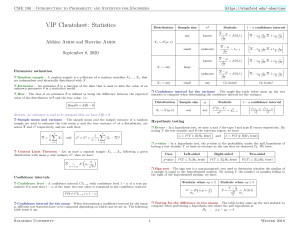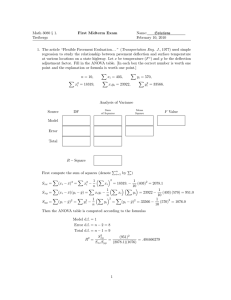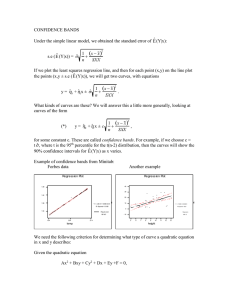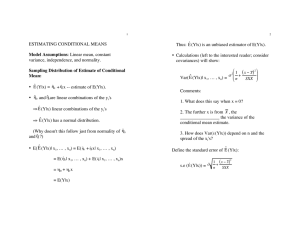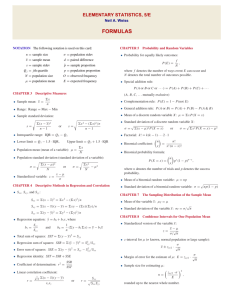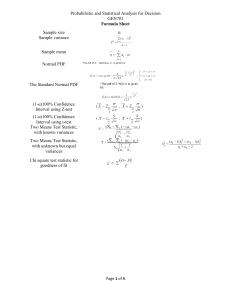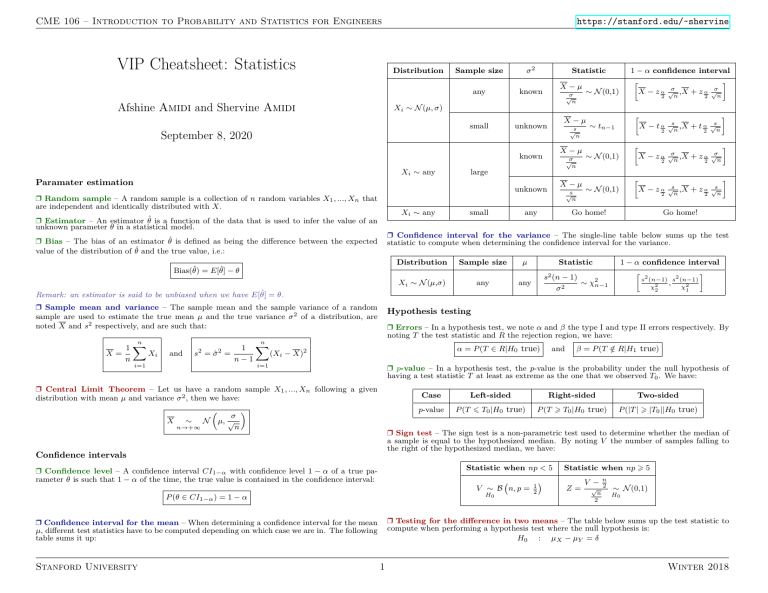
https://stanford.edu/~shervine CME 106 – Introduction to Probability and Statistics for Engineers VIP Cheatsheet: Statistics Distribution Afshine Amidi and Shervine Amidi Sample size σ2 any known small unknown 1 − α confidence interval Statistic X −µ √σ n h ∼ N (0,1) √σ ,X n 2 + zα √s ,X n 2 + tα √σ ,X n 2 + zα √s ,X n 2 + zα X − zα √σ n 2 i Xi ∼ N (µ, σ) X −µ √s n September 8, 2020 X −µ known Xi ∼ any √σ n X −µ unknown Xi ∼ any h ∼ N (0,1) X − tα X − zα √s n 2 √σ n 2 i i large Paramater estimation r Random sample – A random sample is a collection of n random variables X1 , ..., Xn that are independent and identically distributed with X. h ∼ tn−1 small √s n any h ∼ N (0,1) X − zα Go home! √s n 2 i Go home! r Estimator – An estimator θ̂ is a function of the data that is used to infer the value of an unknown parameter θ in a statistical model. r Confidence interval for the variance – The single-line table below sums up the test statistic to compute when determining the confidence interval for the variance. r Bias – The bias of an estimator θ̂ is defined as being the difference between the expected value of the distribution of θ̂ and the true value, i.e.: Distribution Sample size Xi ∼ N (µ,σ) any s2 (n any X= 1 n n X Xi s2 = σ̂ 2 = and 1 n−1 i=1 n→+∞ N σ µ, √ n α = P (T ∈ R|H0 true) X (Xi − X)2 i and β = P (T ∈ / R|H1 true) r p-value – In a hypothesis test, the p-value is the probability under the null hypothesis of having a test statistic T at least as extreme as the one that we observed T0 . We have: Case Left-sided Right-sided Two-sided p-value P (T 6 T0 |H0 true) P (T > T0 |H0 true) P (|T | > |T0 ||H0 true) r Sign test – The sign test is a non-parametric test used to determine whether the median of a sample is equal to the hypothesized median. By noting V the number of samples falling to the right of the hypothesized median, we have: Confidence intervals Statistic when np < 5 r Confidence level – A confidence interval CI1−α with confidence level 1 − α of a true parameter θ is such that 1 − α of the time, the true value is contained in the confidence interval: V ∼ B n, p = H0 P (θ ∈ CI1−α ) = 1 − α 1 2 Statistic when np > 5 Z= V − √ n 2 n 2 ∼ N (0,1) H0 r Testing for the difference in two means – The table below sums up the test statistic to compute when performing a hypothesis test where the null hypothesis is: H0 : µX − µY = δ r Confidence interval for the mean – When determining a confidence interval for the mean µ, different test statistics have to be computed depending on which case we are in. The following table sums it up: Stanford University s2 (n−1) s2 (n−1) , χ2 χ2 2 1 r Errors – In a hypothesis test, we note α and β the type I and type II errors respectively. By noting T the test statistic and R the rejection region, we have: n r Central Limit Theorem – Let us have a random sample X1 , ..., Xn following a given distribution with mean µ and variance σ 2 , then we have: ∼ h ∼ χ2n−1 Hypothesis testing i=1 X − 1) σ2 Remark: an estimator is said to be unbiased when we have E[θ̂] = θ. r Sample mean and variance – The sample mean and the sample variance of a random sample are used to estimate the true mean µ and the true variance σ 2 of a distribution, are noted X and s2 respectively, and are such that: 1 − α confidence interval Statistic µ Bias(θ̂) = E[θ̂] − θ 1 Winter 2018 https://stanford.edu/~shervine CME 106 – Introduction to Probability and Statistics for Engineers Distribution of Xi , Yi nX , nY 2 , σ2 σX Y any known Normal large (X − Y ) − δ q unknown σX = σY q any Di = Xi − Yi + ∼ N (0,1) 2 σY nY H0 s2 X nX + q 1 nX + ∼ N (0,1) s2 Y nY s √D n n X n X (Yi − Ŷi )2 = (Yi − (A + Bxi ))2 = SY Y − BSXY i=1 r Least-squares estimates – When estimating the coefficients α, β with the least-squares method which is done by minimizing the SSE, we obtain the estimates A, B defined as follows: H0 A=Y − ∼ tnX +nY −2 H0 1 nY D−δ unknown SSE = i=1 (X − Y ) − δ s Normal, paired 2 σX nX (X − Y ) − δ unknown small r Sum of squared errors – By keeping the same notations, we define the sum of squared errors, also known as SSE, as follows: Statistic SXY x SXX SXY SXX B= and r Key results – When σ is unknown, this parameter is estimated by the unbiased estimator s2 defined as follows: ∼ tn−1 s2 = H0 nX = nY SY Y − BSXY n−2 and we have s2 (n − 2) ∼ χ2n−2 σ2 The table below sums up the properties surrounding the least-squares estimates A, B when σ is known or not: r χ2 goodness of fit test – By noting k the number of bins, n the total number of samples, pi the probability of success in each bin and Yi the associated number of samples, we can use the test statistic T defined below to test whether or not there is a good fit. If npi > 5, we have: T = ∼ χ2df npi with q α H0 A−α σ df = (k − 1) − #(estimated parameters) 1 − α confidence interval Statistic σ known k X (Yi − npi )2 i=1 Coeff 1 n ∼ N (0,1) A − zα σ 2 2 + X SXX q A−α unknown H0 : no trend versus 2 1+ X n SXX s r Test for arbitrary trends – Given a sequence, the test for arbitrary trends is a nonparametric test, whose aim is to determine whether the data suggest the presence of an increasing trend: B−β known H1 : there is an increasing trend √ ∼ tn−2 A − tα s q 2 q 2 1 n + X SXX 1 n + X SXX ,A + t α s σ SXX ,B + z α √ s SXX ,B + t α √ ,A + z α σ 2 q 2 h B − zα √ ∼ N (0,1) σ SXX q 2 2 2 2 1 n 1 n + 2 + σ SXX X SXX i β If we note x the number of transpositions in the sequence, the p-value is computed as: B−β unknown p-value = P (T 6 x) √ s SXX h B − tα √ ∼ tn−2 2 2 s SXX i Correlation analysis Regression analysis r Sample correlation coefficient – The correlation coefficient is in practice estimated by the sample correlation coefficient, often noted r or ρ̂, which is defined as: √ SXY r n−2 with ∼ tn−2 for H0 : ρ = 0 r = ρ̂ = √ √ SXX SY Y 1 − r 2 H0 In the following section, we will note (x1 , Y1 ), ..., (xn , Yn ) a collection of n data points. r Simple linear model – Let X be a deterministic variable and Y a dependent random variable. In the context of a simple linear model, we assume that Y is linked to X via the regression coefficients α, β and a random variable e ∼ N (0,σ), where e is referred as the error. We estimate Y, α, β by Ŷ , A, B and have: Y = α + βX + e zα Ŷi = A + Bxi and zα 2 2 r Correlation properties – By noting V1 = V − √n−3 , V2 = V + √n−3 with V = 12 ln the table below sums up the key results surrounding the correlation coefficient estimate: 1+r 1−r , r Notations – Given n data points (xi , Yi ), we define SXY ,SXX and SY Y as follows: Sample size n SXY = X n (xi − x)(Yi − Y ) i=1 Stanford University and SXX = n X (xi − x)2 i=1 and SY Y = X Standardized statistic V − (Yi − Y )2 large i=1 2 1 2 ln 1+ρ 1−ρ √1 n−3 1 − α confidence interval for ρ ∼ N (0,1) n1 e2V1 − 1 e2V2 − 1 , e2V1 + 1 e2V2 + 1 X SXX Winter 2018
